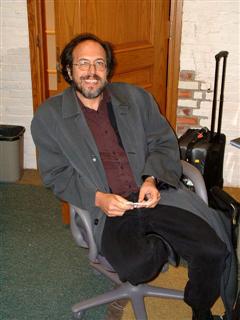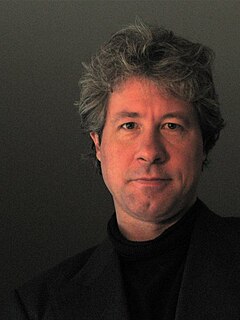Quantum gravity (QG) is a field of theoretical physics that seeks to describe gravity according to the principles of quantum mechanics, and where quantum effects cannot be ignored, such as in the vicinity of black holes or similar compact astrophysical objects where the effects of gravity are strong, such as neutron stars.

In physics, string theory is a theoretical framework in which the point-like particles of particle physics are replaced by one-dimensional objects called strings. String theory describes how these strings propagate through space and interact with each other. On distance scales larger than the string scale, a string looks just like an ordinary particle, with its mass, charge, and other properties determined by the vibrational state of the string. In string theory, one of the many vibrational states of the string corresponds to the graviton, a quantum mechanical particle that carries gravitational force. Thus string theory is a theory of quantum gravity.

A theory of everything, final theory, ultimate theory, or master theory is a hypothetical single, all-encompassing, coherent theoretical framework of physics that fully explains and links together all physical aspects of the universe. Finding a TOE is one of the major unsolved problems in physics. String theory and M-theory have been proposed as theories of everything. Over the past few centuries, two theoretical frameworks have been developed that, together, most closely resemble a TOE. These two theories upon which all modern physics rests are general relativity and quantum mechanics. General relativity is a theoretical framework that only focuses on gravity for understanding the universe in regions of both large scale and high mass: stars, galaxies, clusters of galaxies, etc. On the other hand, quantum mechanics is a theoretical framework that only focuses on three non-gravitational forces for understanding the universe in regions of both small scale and low mass: sub-atomic particles, atoms, molecules, etc. Quantum mechanics successfully implemented the Standard Model that describes the three non-gravitational forces – strong nuclear, weak nuclear, and electromagnetic force – as well as all observed elementary particles.

Lee Smolin is an American theoretical physicist, a faculty member at the Perimeter Institute for Theoretical Physics, an adjunct professor of physics at the University of Waterloo and a member of the graduate faculty of the philosophy department at the University of Toronto. Smolin's 2006 book The Trouble with Physics criticized string theory as a viable scientific theory. He has made contributions to quantum gravity theory, in particular the approach known as loop quantum gravity. He advocates that the two primary approaches to quantum gravity, loop quantum gravity and string theory, can be reconciled as different aspects of the same underlying theory. His research interests also include cosmology, elementary particle theory, the foundations of quantum mechanics, and theoretical biology.

Julian Barbour is a British physicist with research interests in quantum gravity and the history of science.

Carlo Rovelli is an Italian theoretical physicist and writer who has worked in Italy, the United States and, since 2000, in France. He works mainly in the field of quantum gravity and is a founder of loop quantum gravity theory. He has also worked in the history and philosophy of science. He collaborates with several Italian newspapers, including the cultural supplements of the Corriere della Sera, Il Sole 24 Ore and La Repubblica.

Leonard Susskind is an American physicist, who is a professor of theoretical physics at Stanford University, and founding director of the Stanford Institute for Theoretical Physics. His research interests include string theory, quantum field theory, quantum statistical mechanics and quantum cosmology. He is a member of the US National Academy of Sciences, and the American Academy of Arts and Sciences, an associate member of the faculty of Canada's Perimeter Institute for Theoretical Physics, and a distinguished professor of the Korea Institute for Advanced Study.

Erik Peter Verlinde is a Dutch theoretical physicist and string theorist. He is the identical twin brother of physicist Herman Verlinde. The Verlinde formula, which is important in conformal field theory and topological field theory, is named after him. His research deals with string theory, gravity, black holes and cosmology. Currently, he works at the Institute for Theoretical Physics at the University of Amsterdam.
In physics and philosophy, a relational theory is a framework to understand reality or a physical system in such a way that the positions and other properties of objects are only meaningful relative to other objects. In a relational spacetime theory, space does not exist unless there are objects in it; nor does time exist without events. The relational view proposes that space is contained in objects and that an object represents within itself relationships to other objects. Space can be defined through the relations among the objects that it contains considering their variations through time. The alternative spatial theory is an absolute theory in which the space exists independently of any objects that can be immersed in it.
The history of loop quantum gravity spans more than three decades of intense research.

The Road to Reality: A Complete Guide to the Laws of the Universe is a book on modern physics by the British mathematical physicist Roger Penrose, published in 2004. It covers the basics of the Standard Model of particle physics, discussing general relativity and quantum mechanics, and discusses the possible unification of these two theories.

Peter Woit is an American theoretical physicist. He is a senior lecturer in the Mathematics department at Columbia University. Woit, a critic of string theory, has published a book Not Even Wrong and writes a blog of the same name.

Causal dynamical triangulation theorized by Renate Loll, Jan Ambjørn and Jerzy Jurkiewicz, and popularized by Fotini Markopoulou and Lee Smolin, is an approach to quantum gravity that like loop quantum gravity is background independent.

The Trouble with Physics: The Rise of String Theory, the Fall of a Science, and What Comes Next is a 2006 book by the theoretical physicist Lee Smolin about the problems with string theory. The book strongly criticizes string theory and its prominence in contemporary theoretical physics, on the grounds that string theory has yet to come up with a single prediction that can be verified using any technology that is likely to be feasible within our lifetimes. Smolin also focuses on the difficulties faced by research in quantum gravity, and by current efforts to come up with a theory explaining all four fundamental interactions. The book is broadly concerned with the role of controversy and diversity of approaches in scientific processes and ethics.
Jan Ambjørn is a Danish physicist regarded as the primary founder of Causal Dynamical Triangulation Theory (CDT).
Sundance Osland Bilson-Thompson is an Australian theoretical particle physicist. He has developed the idea that certain preon models may be represented topologically, rather than by treating preons as pointlike particles. His ideas have attracted interest in the field of loop quantum gravity, as they may represent a way of incorporating the Standard Model into loop quantum gravity. This would make loop quantum gravity a candidate theory of everything.

In non-technical terms, M-theory presents an idea about the basic substance of the universe. As of 2020, science has produced no experimental evidence to support the concept that M-theory is a description of the real world. Although a complete mathematical formulation of M-theory is not known, the general approach is the leading contender for a universal "Theory of Everything" that unifies gravity with other forces such as electromagnetism. M-theory aims to unify quantum mechanics with general relativity's gravitational force in a mathematically consistent way. In comparison, other theories such as loop quantum gravity are considered by physicists and researchers/students to be less elegant, because they posit gravity to be completely different from forces such as the electromagnetic force.

Time Reborn: From the Crisis in Physics to the Future of the Universe is a 2013 book by the American theoretical physicist Lee Smolin.

James Edward Baggott is a British science writer living in Reading, Berkshire, England who writes about science, philosophy and science history. Baggott is the author of nine books, including Farewell to Reality: How Modern Physics Has Betrayed the Search for Scientific Truth, Origins: The Scientific Story of Creation, Higgs: The Invention and Discovery of the God Particle and The Quantum Story: A History in 40 moments.











